Landing at Haneda airport at 6am is a discombobulating experience. The airport was fairly quiet, neither of us had managed much sleep on the plane, everyone seemed to be wearing surgical face masks (and this was way before the current Covid-19 outbreak), and all the signs were confusing. Luckily, Paul was prepared. Adeptly navigating the building using a site map downloaded back in England, he sourced our pre-ordered portable wi-fi and JR passes with charm and easy. Whilst I groggily bumbled around, trying not to slow him down.
Joining early morning commuters on the monorail to Hamamatsucho, we somehow managed to change onto the Yamanote line and arrive in Shibuya without issue. So far, so good. Having expected to get hideously lost, I have to admit that the hubby’s preparation paid off. With several hours before we could check into our Air BnB, we left our luggage in lockers at the 109 Building (top tip!), posed for photos on the famous scramble crossing and picked up a pastry for breakfast.

Feeling a little more alive, and a lot more amenable to Tokyo, we embarked on our first day of sight-seeing, heading away from the bustle of Shibuya and up to the calm serenity of Meiji Jingū Shrine. It was a really hot day and the route took us alongside and over large expanses of tarmac, but the slog was worth it. The impressive complex is dedicated to the deified spirits of Emperor Meiji and his wife, Empress Shōken, and is a great introduction to the city. Walking under big, stone torii gates and past rows of kazaridaru (sake barrels) – serving as decorative displays honouring the gods – we found ourselves arriving at the shrine just as a wedding procession was passing through.

Learning that you need to wash your hands, rinse your mouth and spit out before entering a shrine, and that bow-bow-clap-clap-bow (or ni-rei ni-hakusyu ichi-rei, in Japanese) is the appropriate order when showing gratitude to the gods, we felt duly set up for the rest of our trip! Having explored the buildings, we walked through the gardens and down to the koi pond, noting the requisite heron and turtles. See my Kyoto blog for a fuller explanation of their significance in Japanese lore.
After all that walking, we were hungry again, so walked down Omotesandō (a popular tree-lined shopping street) and tucked into grilled gyoza and miso cucumber at Harajuku Gyouzarou. And, for good measure, some kaarage chicken at Commune 2nd, a nearby street food yard (think Dinerama, if you’re a Londoner).

Wandering the cable-strewn backstreets, we popped out at Takeshita Dōri – the teenage epicentre of Tokyo. I can’t quite describe how bonkers this street is: it’s full of candy-floss eating, selfie-posing princesses, mingling with platform-trainer-wearing punks and leather-attired goths, all of them eating bubble-gum pink ice-cream and disappearing into mysterious apartments advertising photo ops with litters of mameshiba puppies. Yeah, me neither! You can find some of my photos of the area at Nihon no seikatsu and in my food blog 29 Seasons of Tofu. It couldn’t be more different to the shrine we’d visited earlier, with it’s solemn, votive-wielding pilgrims. But that’s the beauty of Japan, and of Tokyo in particular: the ultra-modern and the ancient happily co-existing.
Needing a rest, we navigated back to the scramble crossing, picked up our luggage and attempted to find our Air BnB, which – with the aid of our protable wi-fi – we were assured was very close. Another tip for you: do not attempt to short-cut through the Mark City Building to reach…anywhere! After our fourth attempt at finding a top-floor exit and more trips up and down escalators than anyone needs in a lifetime, we finally emerged – sweaty and grouchy – vowing always to take the ‘long route’ from now on. Luckily, the flat really wasn’t far from that point, tucked away on Sakuragaokacho. Like most accommodation in Japan, it was TINY. But had a comfy bed, and that was all that mattered. We would stay in much more impressive home-stays and hotels on the rest of our trip, but had judged – correctly – that Tokyo wasn’t the place to bother. We hardly spent any time at all in the flat.
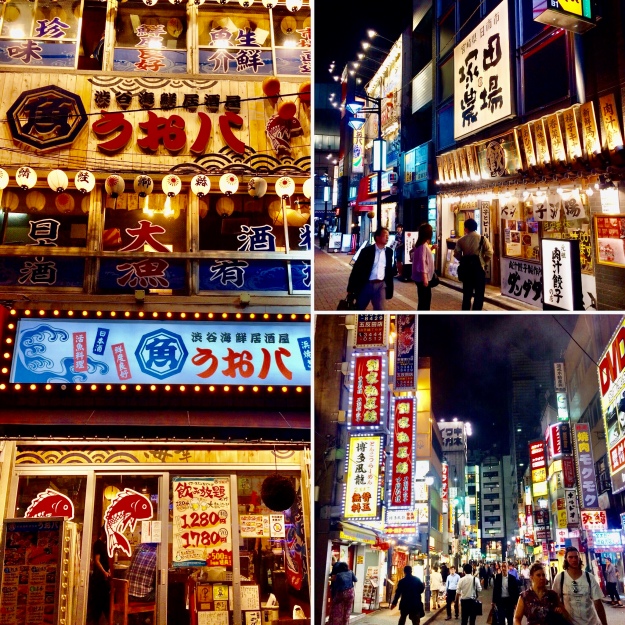
In the evening, we explored the neighbourhood and ate amazing yakiniku (Japanese barbeque) at Han no Daidokoro Bettei. Again, I won’t repeat what’s in my food blog – so check that out for a full description and photos.
The next morning saw us in Tsukiji Market. What a fantastic place! It’s exactly what I wanted it to be: crowded, vast, smelly, colourful, rough-around-the-edges, and absolutely bursting with fantastic food stalls, offering delicacies I’d never tried before (and some I possibly won’t ever try again!). The fresh, grilled eel slathered in sticky soy was particularly good; as was the octopus and cabbage croquette, black pig dumpling, tamagoyaki (sushi omelette made in traditional tin skillets); scallops in miso; dried pond fish, nikuman (pork bun), tuna sashimi and matcha ice-cream. You need to be a little assertive, pointing clearly at what you’d like and thrusting money at the stallholders. Otherwise, you get shouted over by the hundreds of Japanese locals and tourists who are just as eager to try everything.
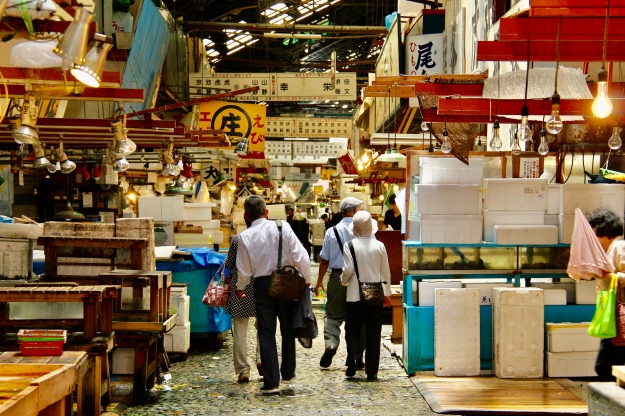
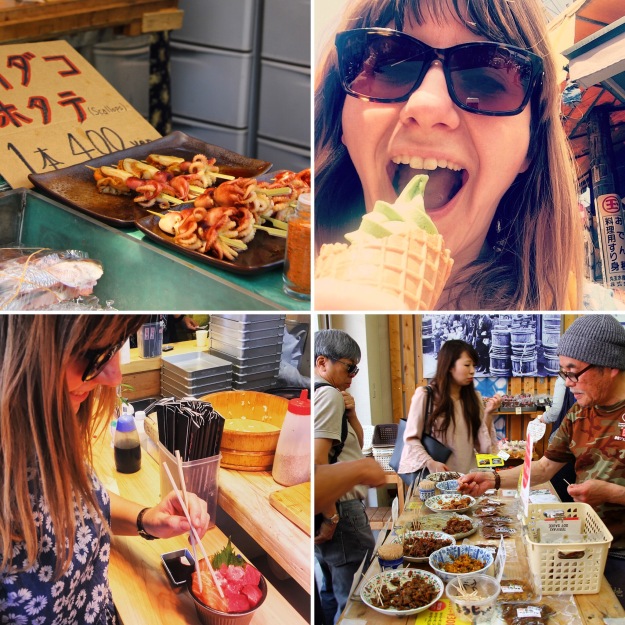
It’s also worth exploring the inner market, where the tuna and other wholesale fish auctions take place each morning. You have to be there super-early to witness it in action – we didn’t make it this time – but it’s definitely worth popping into anyway, to catch the military wash-down and clean-up operation.
Close to the market are a couple of shrines worth poking your nose in and the beautiful Hama-rikyū Onshi-teien gardens. Like so many of the parks and gardens in Japan, I’d definitely like to return to see at its peak: with autumn foliage or adorned with cheery blossoms. Whilst generally green and lacking flora at this time of year, the Edo-period expanse was a welcome respite and the central pond, traditional tea-house and vantage points over nearby Ginza district were great.

From Hama-rikyū, you can catch a waterbus to Asakusa. Cue Pitch Perfect jokes (you’ll know if you know). The trip up the river is interesting enough in itself, the boat passing by factories, high-rises and gleaming glass edifices – a bit like a trip on the Thames to Canary Wharf. But, it’s the destination that’s the killer: Sensō-ji temple in Asakusa. Completed in 645, it’s Tokyo’s oldest temple – a bright red, busy daily place of worship smack bang in the middle of a commercial district. Legend has it that two brothers “caught” a statue of Kannon, the goddess of mercy, whilst fishing in the Sumida River; and even though they tossed the statue back, it kept returning to them. So the temple was built in honour of Kannon.
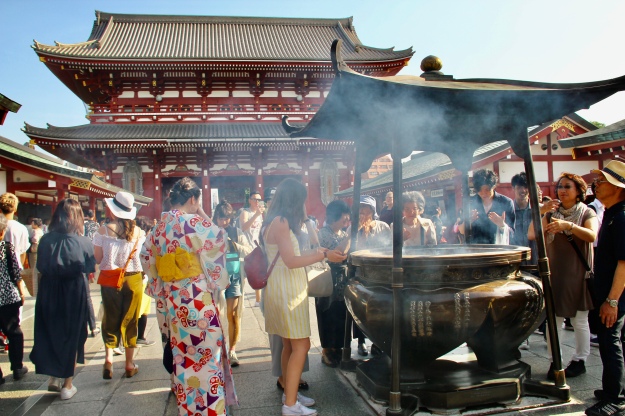

You enter through Kaminarimon (the Thunder Gate), proceed down Nakamise – a centuries’ old, 200 meter long shopping street – and reach the second gate, Hozomon, through which you find the main hall, shrine and five-storey pagoda. People flock here to ‘bathe’ in holy smoke from the massive incense burner (the jokoro), believed to heal wounds, and to give thanks to the goddess. I’d have liked to stay longer and see the complex illuminated at sunset, but it had already been a long day…
With aching legs, we made our way home to Shibuya, to shower and change for dinner. A very swish and tasty meal at Argile in Ginza (highlights being the crunchy red snapper with dashi and the barbary duck with shitake) was followed by digestifs at Bar Evans and Fire, and an obligatory Japanese whisky in Nonbei Yokocko (‘drinker’s alley’), at a bar so tiny only about three people could fit in at any one time.
Day three in the city, our last before heading off to Kyoto, was mainly spent taking in some modern art and culture in Roppongi. Admiring the stunning National Art Center, visiting a sensational exhibition of Japanese Architecture at the Mori Art Museum, and taking in ‘Tokyo City View’
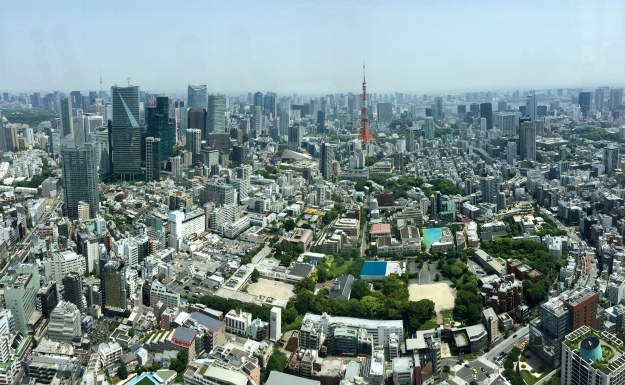
Later in the afternoon we visited the district of Daikanyama, often referred to as the Brooklyn of Tokyo: all cute coffee shops, micro-breweries, chocolate shops and various buildings featured in the Wallpaper guide. If I visit again, I’d choose to stay in this neighbourhood. Whilst there, we also popped into the Kyu Asakura House, a private ‘mansion’ residence built in the early 20th century, surrounded by a roji-style garden with sculpted bonsai, bright moss covered tree roots, stone lanterns, and colourful flowers and shrubs. Would certainly recommend a visit.
Our final evening was spent chasing the elusive perfect yakitori in Omoide-Yokocho (‘Memory Lane’), a maze of little alleys near Shinjuku station (officially the scariest in the world). Then drinking too much rum and whisky in JBS, a tiny bar run by a jazz, soul and blues vinyl enthusiast who doesn’t seem to speak a word of English (or chooses not to). An odd experience, since he seems to close the bar at whatever time he chooses, and admit or refuse people at whim. We were obviously deemed acceptable, but a backpacker who arrived 30 minutes later, and had clearly sought the place out, was turned away. Not complaining though: it adds to the secretive allure of the place. A great way to end our stay in the city.


